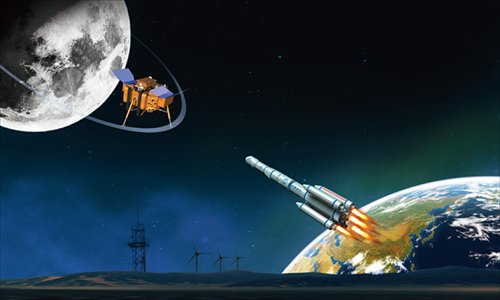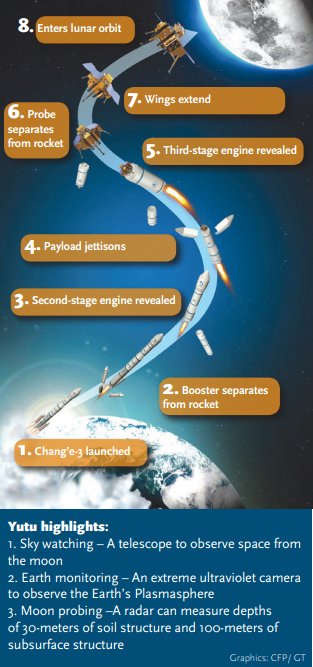Moonshot to test rover's soft-landing

Long March-3B rocket and moon rover Chang'e-3. Illustration: CFP
China's launch of the Chang'e-3 lunar probe to the moon on Monday from Xichang Satellite Launch Center in Sichuan Province marks the first time that China has sent a spacecraft to soft land on the surface of an extraterrestrial body.
Carrying a moon rover named Yutu, or Jade Rabbit, Chang'e-3 is expected to land on the moon in mid-December and will conduct a three-month survey of the moon's geological structure, according to the State Administration of Science, Technology and Industry for National Defense (SASTIND).
The Chang'e-3 lunar probe will allow researchers to carry out astronomical research from the moon for the first time, take EUV images of the Earth's plasmasphere for the first time and use radar to measure the Moon's soil layers.
If the soft-landing mission of the Chang'e-3 lunar probe is successful, China would become the third country in the world to have achieved that feat.
So far, only the US and the former Soviet Union soft-landed on the moon in the 1960s and 1970s. China, Japan, India and the Paris-based European Space Agency (ESA) have launched circumlunar orbiting satellites successfully, several of which had controlled hard-landings on the Moon.
Pang Zhihao, a research fellow with the Chinese Academy of Space Technology, told the Global Times that competition among countries which haven't landed on the Moon is keen.
"A successful soft-landing mission will indicate that China is one step ahead in the race for lunar exploration, demonstrating the national power politically and providing technical support for further lunar exploration," Pang said.
Pang noted that the soft-landing mission of Chang'e-3 lunar probe is crucial for the detailed survey of the Moon's surface and future Chinese missions, which may focus on collecting samples to return to earth and deep space exploration.
The Chang'e-3 lunar probe is the second step of China's three-step lunar exploration program, which started in 2007. The country is looking for the possibility to send the first astronauts to set foot on the Moon between 2025 and 2030, according to Pang. The government has not formally disclosed a clear period for manned landing.
After entering lunar orbit, the Chang'e-3 will go through six stages of deceleration to descend from 15 kilometers above to the lunar surface.
The chosen landing area of the probe, known as the Bay of Rainbows, is untouched by earlier lunar missions. Sun Zezhou, the Chang'e-3 chief designer, told the Global Times that the exact touch-down spot will be decided later according to the flight deviation, launch window and other elements.
The probe will be launched to orbit aboard an enhanced Long March-3B carrier which is the most powerful launch vehicle in the Long March fleet.
Compared with the Chang'e-2 lunar orbiter, launched in October 2010, the Chang'e-3 is 1,000 kilograms heavier and its orbit injection is over three times more accurate.
Yutu is designed to run 200 meters per hour on the rocky surface of the Moon, approximately at the same speed as the US Mars rover. Yutu has the capability of moving forward and backward, turning, climbing and changing routes to avoid obstacles.
So far, a total of 129 lunar exploration programs have been carried out by six countries and regions, namely the US, former Soviet Union, Japan, China, the ESA and India. Among them, 66 programs were successful.
Pang said that lunar exploration would benefit not only space science research but also economic development. "New materials and techniques developed in this mission, such as robots and buffering materials, can be used in domestic industry," said Pang.
Xinhua contributed to this story

The launch of Chang'e-3. Illustration: GT
